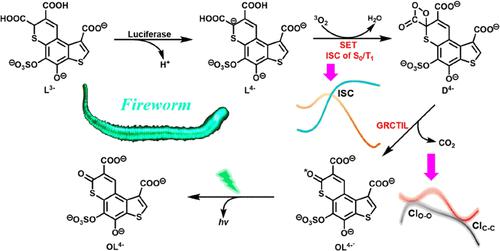当前位置:
X-MOL 学术
›
J. Phys. Chem. A
›
论文详情
Our official English website, www.x-mol.net, welcomes your
feedback! (Note: you will need to create a separate account there.)
Chemical Mechanism of Fireworm Bioluminescence – A Theoretical Proposition
The Journal of Physical Chemistry A ( IF 2.7 ) Pub Date : 2023-12-16 , DOI: 10.1021/acs.jpca.3c07409 Zhuo Quan 1 , Yoshihiro Ohmiya 2 , Ya-Jun Liu 1, 3
The Journal of Physical Chemistry A ( IF 2.7 ) Pub Date : 2023-12-16 , DOI: 10.1021/acs.jpca.3c07409 Zhuo Quan 1 , Yoshihiro Ohmiya 2 , Ya-Jun Liu 1, 3
Affiliation

|
Odontosyllis undecimdonta is a marine worm, commonly known as a fireworm, that exhibits bluish-green bioluminescence (BL). The luciferin (L) and oxyluciferin (OL) during fireworm BL have been experimentally identified in vitro. The L and OL are the respective starting point and ending point of a series of complicated chemical reactions in the BL. However, the chemical mechanism of the fireworm BL remains largely unknown. Before the experiments provided strong evidence for the mechanism, based on our previously successful studies on several bioluminescent systems, we theoretically proposed the chemical mechanism of the fireworm BL in this article. By means of the spin-flip and time-dependent density functional calculations, we clearly described the complete process from L to OL: under the catalysis of luciferase, L undergoes deprotonation and reacts with 3O2 to form a dioxetanone anion via the single-electron transfer mechanism; the dioxetanone anion decomposes into the OL at the first singlet excited state (S1) by the gradually reversible charge-transfer-induced luminescence mechanism; and the S1-OL emits light and deexcites to OL in the ground state.
中文翻译:

火虫生物发光的化学机制——一个理论命题
Odontosyllis undecimdonta是一种海洋蠕虫,俗称火虫,具有蓝绿色生物发光 (BL)。火虫BL期间的荧光素( L )和氧化荧光素( OL )已在体外通过实验鉴定。 L和OL分别是BL中一系列复杂化学反应的起点和终点。然而,火虫BL的化学机制仍然很大程度上未知。在实验为该机制提供强有力的证据之前,基于我们之前对几种生物发光系统的成功研究,我们在本文中从理论上提出了火虫BL的化学机制。通过自旋翻转和时间相关的密度泛函计算,我们清楚地描述了从L到OL的完整过程:在荧光素酶的催化下, L发生去质子化,并通过单- 3 O 2反应形成二氧杂环丁酮阴离子。电子转移机制;二氧杂环丁酮阴离子通过逐渐可逆的电荷转移诱导发光机制在第一单重激发态(S 1 )分解成OL ; S 1 - OL发光并退激发至基态的OL 。
更新日期:2023-12-16
中文翻译:

火虫生物发光的化学机制——一个理论命题
Odontosyllis undecimdonta是一种海洋蠕虫,俗称火虫,具有蓝绿色生物发光 (BL)。火虫BL期间的荧光素( L )和氧化荧光素( OL )已在体外通过实验鉴定。 L和OL分别是BL中一系列复杂化学反应的起点和终点。然而,火虫BL的化学机制仍然很大程度上未知。在实验为该机制提供强有力的证据之前,基于我们之前对几种生物发光系统的成功研究,我们在本文中从理论上提出了火虫BL的化学机制。通过自旋翻转和时间相关的密度泛函计算,我们清楚地描述了从L到OL的完整过程:在荧光素酶的催化下, L发生去质子化,并通过单- 3 O 2反应形成二氧杂环丁酮阴离子。电子转移机制;二氧杂环丁酮阴离子通过逐渐可逆的电荷转移诱导发光机制在第一单重激发态(S 1 )分解成OL ; S 1 - OL发光并退激发至基态的OL 。


















































 京公网安备 11010802027423号
京公网安备 11010802027423号